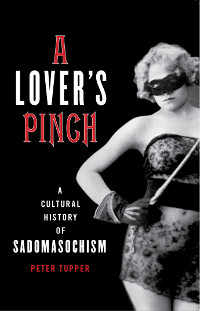Desmond, Marilyn. Ovid’s Art and the Wife of Bath: The Ethics of Erotic Violence Cornell University Press, 2006 Google Books
Desmond’s book starts off with telling how people objected to the inclusion of an informational panel on consensual sadomasochism at a feminist conference in New Paltz in 1997. This set off a media firestorm across the US. A similar controversy flared up in 1982 over the Barnard College conference that eventually led to Pleasure and Danger anthology, and was one of the inciting incidents in the 1980s iteration of the “sex wars.”
The New Paltz conference fifteen years later demonstrates that S/M remains an “alarming symbol,” even when its practitioners stress its contractual and consensual nature–as they did in the conference program–and even though popular culture, especially advertising and fashion (Versace, Gaultier) is saturated with S/M imagery.
Pg. 3
As such, violence against women constitutes a form of “structural violence” in the contemporary West. By contrast, the theatricality of S/M demonstrates that such hierarchies are inventions, and unstable inventions at that. Commercial and consensual S?M are aggressively policed in Britain and the United States while domestic violence has generally been tolerated in both countries as part of the status quo; perpetrators of domestic abuse, unlike S/M practitioners, are not classified as sexual outlaws.
Pg. 4
While S/M scripts parody the formations of power and fetishize the instruments of violence, such parodies and fetishistic operations frequently rely on historical configurations. Michel Foucault described S/M as a form of courtship, in which “sexual relations are elaborated and developed by and through mythical relations.”…. Premodern history offers intense opportunities for staing power in theatrical erotics since the semiotics of power relations in premodern cultures are popularly though to be crudely figured in terms of dominance and submission or starkly organized into social institutions such as feudalism or the Church…. Perhaps this is why Slavoj Zizek sees masochism and courtly love as direct reflections of one another….
Pg.4-5
Desmond cites an essay by Anna Freud, “Beating Fantasies and Daydreams” (1922), which follows up from her father’s “A Child is Being Beaten.” This shows an individual process of how one person takes a story and revises it repeatedly, turning it from a tale of violence to a tale of suffering and redemption.
Anna Freud’s case study suggests that narratives adapted–however loosely– from an identifiable past such as the medieval West provide a superstructure of fantasy that facilitates an erotic paradigm. If medieval scripts can be read through masochism–as Zizek sees it–or if they facilitate masochistic fantasy–in Anna Freud’s terms–perhaps the constructs of the medieval past might elucidate specific performances of contemporary heterosexualities, particularly in terms of erotic violence.
Pg. 5-6
What Desmond does in this book is trace out the genealogy of Western civilization’s views on the relationship between eros and violence.
Classical roman society was intensely hierarchical, and a Roman man was expected to keep order in his household (which included wives, family members and slaves) through words or blows. St. Augustine saw violence as an integral part of domestic order and affection, as an expression of marital love. Medieval marriage manuals, if not condoning violence against women, told women to suck it up and bear it. The consensus of laws in the period was that husbands had the right and duty to “correct” their wives physically, within some “reasonable” limit.
The root of this particular tree is Ovid’s Ars Amatoria, written around 2 CE. It’s a three-part elegy poem, with the first two parts telling the male reader how to seduce woman, and the third telling women who to act in such circumstances. Ovid wrote it in early days of imperial rule, when Augustus imposed new laws to strengthen marriage and penalize adultery, brought on by fear of declining birthrates and not enough citizens to maintain an army. (Cf. Foucault’s bio-power)
Marital reproduction thus became a legal obligation in order to further the goals of Roman conquests and colonial occupation. By contrast to such official policy, the Ars defines amor as an experience that can only take place outside of marriage, and it is completely silent on the reproductive consequences of heterosexual performance. The Ars thereby mocks the assumptions of Augustus’ marriage legislation that sexuality can be regulated by law.
…
The heterosexual script as it develops in the course of the Ars emerges from the structures of imperialism so that the praeceptor’s [instructor’s] discourse of sexual domination and conquest mimics the discourses of Roman coloniality.
Pg. 36
This is perhaps the most interesting aspect of Ovid’s work, that it was meant at least in part as a satire of the newly expansionist and martial state, which intruded into private matters. A Roman would have got the joke; a Frenchman a thousand years later wouldn’t. (This ties into two other themes I’ve noticed in the history of BDSM: imperialism/colonialism, and the misreading of texts.)
There is a masochistic side to this, when Ovid advises his pupil to occasionally and strategically debase himself before his domina (mistress, or woman in charge of household slaves). “Don’t think it a disgrace to suffer curses or blows from the girl, or plant kisses on her tender feet.” (2.533-34)
This voluntary subjugation–which the praeceptor offers as a theatrical role the lover might effectively adopt–is derived from the topos of the servitum amoris. In Latin amatory poetry, the metaphor of the lover as servus to an all-powerful domina provided a rhetorical formula for expressing the emotional agency of the puella [girl]– an agency which amounted to her ability to withhold affection and sexual favors from the lover; her ability to exercise any control over her own sexuality, that is, made her all-powerful… The praeceptor only suggests the pose of the servitum amoris as a means for the lover to consolidate his power over his puella.
Pg. 46
These ideas of how a passionate relationship should be conducted were carried into the centuries that followed. The great medieval lovers, Abelard and Heloise, referred to Ovid’s works, including the Ars amatoria.
The female reader of Ars amatoria 3 who disregards the irony of Ovid’s didactic discourse would find herself situated as the object of eroticized violence in an elaborate power play in which she could only acquire recognition through submission.
Pg. 57
Ovid’s semi-serious advice mixed up with Heloise’s uncle’s instruction to Abelard that “if I [Abelard] found her to be careless, I should constrain her severely.”
I’m not quite sure what to make of the Abelard/Heloise relationship. I know there was a reference to what sounded like spanking in Abelard’s account, but according to this book, this was not unusual. In the medieval pedagogical tradition, it was considered perfectly normal for teachers to beat their pupils, and otherwise be physically intimate with them. The scandal might actually be because of the fact that Heloise was remarkably well educated for a woman of her place and time, so this student/pupil relationship, usually confined to the homosocial/homoerotic all-male world, butted up against the heterosocial/heteroerotic world.
It didn’t end well. Heloise got pregnant, Abelard squirreled her off to a convent and her uncle castrated him. They continued to write each other. (This is the when the letters by Heloise start.) Curiously, she never mentions her pregnancy or child, perhaps echoing Ovid’s silence on the subject, so to speak.
The Abelard/Heloise relationship actually reminds me greatly the Munby/Cullwick relationship. Both relationships appear exploitative and intensely hierarchical at first glance, but on further examination reveal a much more complex interplay of fantasies, roles and power.
Heloise wrote to Abelard that she would rather be his meretrix (a high-level courtesan) than imperatix (the empress). (Pg.64) This is echoed in Cullwick’s statements that she would rather be Munby’s maid of all work than his bourgeois wife. In one of Heloise’s letters, she said that their relationship was not just teacher/pupil, but also father/daughter, husband/wife, brother/sister, all of which were based on the classical dominus/ancilla (master/slave) relationship. (pg. 62) (This is different from the more complex roleplaying of Munby and Cullwick, in which she was often the dominant role, both as a maternal figure and as a more masculine figure than Munby.) Heloise’s letters seem like she’s trying to top him from the bottom, demanding her recognition as his submissive lover. In effect, she’s saying he owes her attention and recognition, and that he isn’t playing his role properly.
So, were Abelard and Heloise a BDSM couple as we would recognize it today? Sort of. I think the difference is, and this is something that Desmond never quite puts her finger on, is that the word punishment in BDSM should always have quotes around it. In the ancient and medieval traditions Desmond writes about, violence is used as a punishment, not a “punishment,” as a means of controlling the subordinate party. If the subordinate party wants to be beaten, then the entire strategy falls apart.
Desmond’s book does raise the idea that violence and eros in Western civilization has been coupled together at a very deep level. She cites Foucault to say that Ovid’s poetry provided a kind of script that informed other depictions of heterosexual relationships in later times, a set of theatrical gestures that could be manipulated, re-read and mis-read.

Desmond also discusses the “Mounted Aristotle”, a visual and literary reference that began in the 13th century and recurs in many different works. The most common form is a older man, whose age and dress indicates his learnedness, on all fours, with a woman riding him as a horse, often wielding a whip. The story behind it, which has no basis in classical records, is that Aristotle was tutor to Alexander the Great in India. Aristotle chides Alexander for being too smitten by his wife or mistress, usually named Phyllis. As revenge, Phyllis seduces Aristotle, and he agrees to let her ride him as a horse. She also arranges for Alexander to watch this. (Note the elements of voyeurism and humiliation, common in fantasies.)
I bring this up because I want to make it clear that people should not look at this particular image and anecdote and immediately say, “Aha, people in the 13th century were kinky just like us.” The mounted Aristotle was viewed in a variety of different ways and contexts, including references to contemporary politics. It was not only an erotic image. It was also a warning against the seductiveness of women, yet also a rueful admission that even the wisest of men are susceptible. Yet the perverse erotic meaning is within the image, there to be read, and provide a seed for fantasy. In a horse-based culture, equestrian metaphors would have had a lot of currency.
The fantasy of the “mounted Aristotle” shaped the language of erotic violence in medieval French and English narratives so that a cultural notion of the scandal of female dominance could be cited visually or textually in equestrian images or metaphors. The erotic potential of such equestrian fantasies remains a recognizable feature of modern power erotics.
Pg. 27






